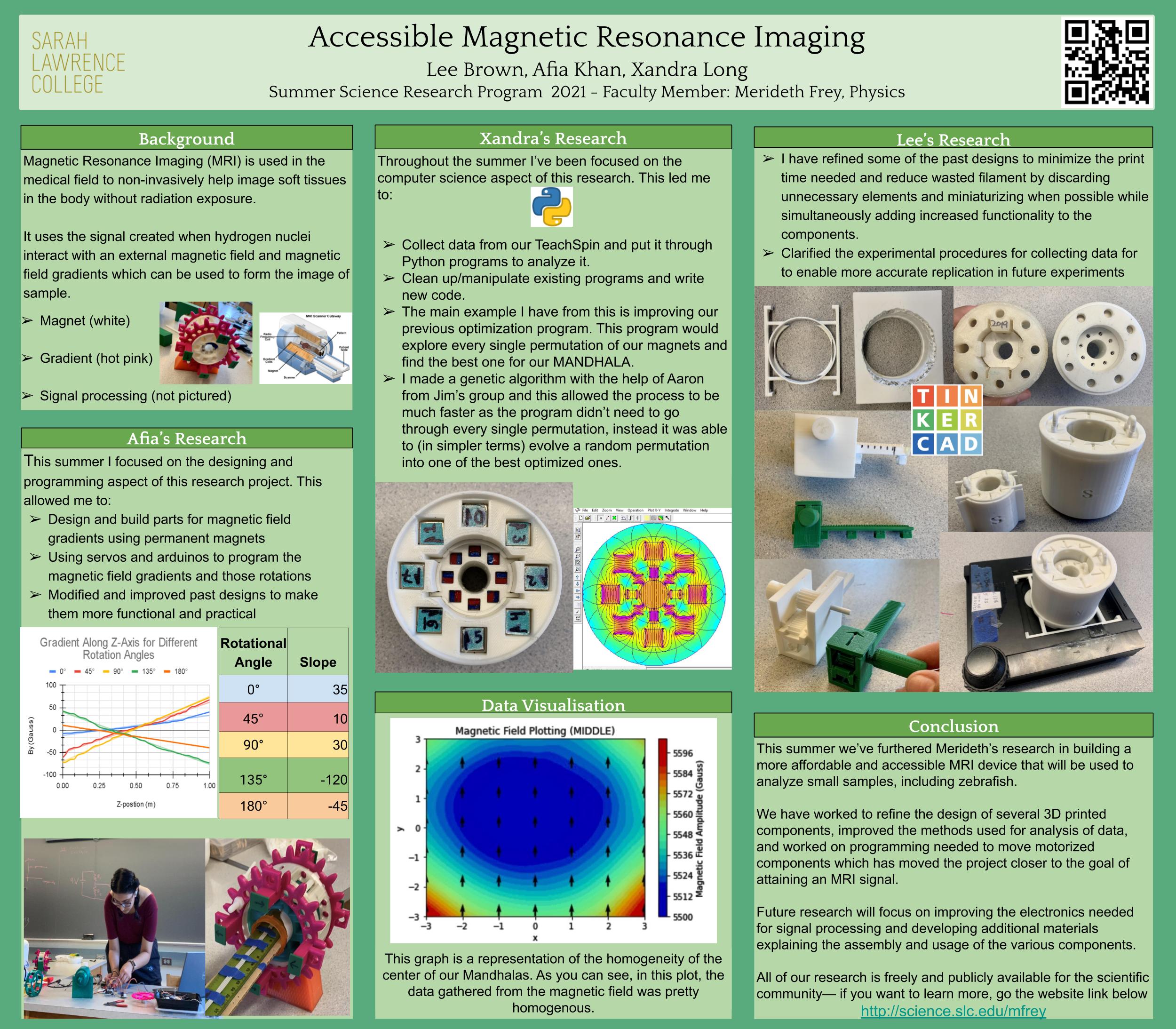 Link to PDF of poster shown above
Link to PDF of poster shown above
This summer, the Sarah Lawrence Summer Science Program was back! Three brave students came into the lab to continue the work of designing and building an affordable and accessible MRI system. They created the poster above to highlight their various projects, and links to their more detailed reports of their work can be found below.
Improving Upon Our Optimization Algorithm
Xandra Long (future computer science engineer) was our main computer programmer. Her work included updating many of our NMR data analysis templates, along with taking lots of data from our TeachSpin benchtop NMR system. Her primary work was updating our optimization procedure so it could work with more magnets. Instead of going through all possible permutations of the magnets, she incorporated a genetic algorithm to only sample some of the possible permutations and evolve towards better permutations. This gives us much more freedom to make our optimization algorithm even better by potentially optimizing both inner and outer Mandhalas together (instead of separately). Read more about Xandra’s work here!
Updated MANDHALA Models and Accessories
Lee Brown was our resident TinkerCad guru, who recreated many of the 3D print models in TinkerCad to polish up the design and make everything very user-friendly. You can learn more about his new Mandhala designs here.
Lee also made several new pieces of equipment to help more safely insert magnets and more accurately do measurements. More details can be found here.
With an eye to the future, Lee also wrote up a lab protocol for magnetic field mapping so that measurements across summers and taken by different students can all be more uniform. Lee also wrote up a thorough guide to TinkerCad, with a focus on the skills most useful for creating models necessary for our research.
Improving Upon Our Gradient Design
Afia Khan worked with Arav Misra on improving our gradient design using permanent magnets, particularly figuring out how everything can be constructed and moved mechanically through use of servo motors controlled via Arduino. This turned out to be more of a struggle than anticipated, but we found solutions for all the obstacles we encountered and have a clear path forward for how we can mechanically move the gradients and sample to effectively do imaging.
Possible future steps:
Now that we have a working genetic algorithm, we can further optimize it (using the suggestions Xandra has in her blog post), and use it to do BOTH sets of MANDHALAS at the same time, to find potentially even better configurations where optimized magnet placements in the center ring can help correct for magnet field inhomogeneities caused by the outer ring, and vice-versa.
Even optimizing the magnet placements, our magnetic field homogeneity (7 - 12 Gauss/mm) is about 10 times worse than the TeachSpin system (~1 Gauss/mm). We may want to design and construct electromagnetic shim coils for higher homogeneity.
Our homogeneity may need improvement for high resolution NMR and imaging, but should be capable of seeing NMR signal (just perhaps 10 times worse signal due to magnetic field homogeneity, if all else is equal). However, we still need to determine if our RF resonant tank circuit is ideally tuned and matched, since we haven’t had a way to check the impedance matching of our circuit by measuring the reflection. To check this, we can trying making use of the constant wave (CW) module of the TeachSpin, which essentially acts like a reflectometer. This will help us optimize our home-made RF tank circuit. We also have a newly purchased directional coupler that can be used independent of the TeachSpin system using the RF processor.